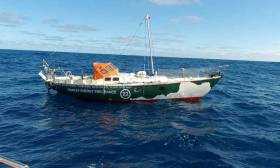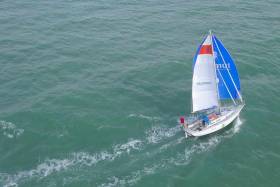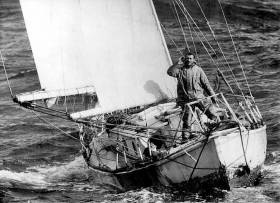Displaying items by tag: Golden Globe
Melissa Payne Takes the Helm for Golden Globe Race
Following a 12 month Media blackout with respect to the Global Pandemic, The 2022 Golden Globe and 2023 Ocean Globe Races are now back in the news with a permanent office opened in Les Sables d’Olonne, France and a major Media appointment to the management team. The Golden Globe Race currently has 28 entrants from 11 countries and the Ocean Globe Race 26 entrants from 17 countries, including Ireland.
The entry list includes Pat Lawless from Limerick as Afloat previously reported.
Don McIntyre founder of the Ocean Globe Race (OGR) and the Golden Globe Race (GGR) announced today in Les Sables d’Olonne, that former senior IMG executive Melissa Payne, is now officially Chief Executive Officer (Media) for the two, historic, round-the-world sailing events.
Payne, who left IMG last year after 20 years, was previously Vice President, Head of Technical Services and also Head of Sailing/ Nautical Sports at IMG Media. During her time at IMG, she worked on two America’s Cups, the World Match Racing Tour, Extreme Sailing Series, the Volvo Ocean Race and the H20 series.
Her new role will oversee all media requirements for the two events, including sponsorship, media sales, production and distribution. She is currently in the process of assembling an experienced team, to work across both events. The GGR starts in Sept 2022 and the OGR in Aug 2023 - marking the 50th anniversary of the original Whitbread/Volvo Ocean Race.
 Don McIntyre founder of the Ocean Globe Race (OGR) and the Golden Globe Race (GGR)
Don McIntyre founder of the Ocean Globe Race (OGR) and the Golden Globe Race (GGR)
Don McIntyre, also Race Chairman of the GGR and OGR, said: “ This appointment kick starts our event promotions following a 12-month delay due to Covid. We are really excited to have Melissa and her team onboard. She comes with a huge amount of knowledge and is passionate about all sports, but, in particular, sailing. She brings an impressive track record to the table and understands the value of our unique retro events, which focus on the human story, adventure and extraordinary challenges, for ordinary, not elite, sailors.”
Payne said: “Sailing has always been my passion and these are two incredibly exciting and tough races that will capture the imagination of sailors and non-sailors, across the globe. For me, it’s great to have an opportunity to look after projects from a 360° stand-point and look to secure the widest possible exposure and success, for both events.”
She added: “There will be a number of different sponsorship opportunities for brands and companies to become involved with, in both the GGR and OGR, each of which has its own unique appeal; and, I am extremely excited to be working alongside Don and his team.”
 Robin Knox-Johnston, winner of the 1968 Sunday Times Golden Globe Race. Photo: PPL
Robin Knox-Johnston, winner of the 1968 Sunday Times Golden Globe Race. Photo: PPL
The Golden Globe Race is the original round the world yacht race, where, in 1968, Sir Robin Knox-Johnston became the only sailor to complete the first, solo, non-stop, round-the-world sailing race. In 2018, in celebration of 50 years since that first record-breaking achievement, the Golden Globe Race was resurrected. It returns again in September 2022 from Les Sables d’Olonne.
 'Sayula II' skippered by Ramon Carlin, returning to Portsmouth to win the first Whitbread Round the World Yacht Race Photo: PPL
'Sayula II' skippered by Ramon Carlin, returning to Portsmouth to win the first Whitbread Round the World Yacht Race Photo: PPL
The Ocean Globe Race is a fully crewed, retro race, in the spirit of the 1973 Whitbread round-the-world Race and marks the 50th Anniversary of the original event. Starting in Europe in September 2023, the OGR is a 27,000-mile sprint around the Globe. Encompassing four legs, which take in the Southern Ocean and three great Capes.
Payne joins three other key personnel, Sebastien Delasnerie (Joint Media Director), Aida Valceanu (Public Relations and Major Events OGR) and Jane Zhou ( Finance and Admin).
2018 Golden Globe Race Attracted Multiple Millions In Publicity Worldwide
Independent analysis on media coverage during the 2018 Golden Globe Race says the event attracted worldwide coverage worth as much as US$185 million.
Les Sables d’Olonne, which will be the host start and finish port again in 2022, gained two years of international publicity valued at €16.5 million.
And Falmouth — which hosted the pre-race Suhaili 50 Parade of Sail, celebrating the 50th anniversary of Sir Robin Knox-Johnston’s departure in the original 1986 Sunday Times Golden Globe, as well as the start of the SITraN Challenge race to Les Sables d’Olonne — gained £1.85m (US$2.38m) from its three days of events.
Golden Globe Race founder Don McIntyre said today: “What a fantastic, solid result for a unique original adventure created by a small passionate management team with low budgets.
“It confirms the support and huge following the 2018 GGR achieved from ordinary people interested in a simple, back to basics human endeavour. No fluff; just an honest, down-to-earth non-stop solo race around the world that media understand.
“We must also thank the passion of our French fans and our enthusiastic host port and logistics partner Les Sables d'Olonne, Ville and Agglomeration. The GGR family continues to grow, ensuring the 2022 edition will be an even bigger success.”
Yannick Moreau, Mayor of Les Sables d’Olonne and president of the Agglomeration said: “For a first edition, the GGR has been an international success. I am looking forward to the second edition from Les Sables d’Olonne on September 4, 2022.”
With three years to go until the start of the next Golden Globe Race, only one ordinary and five special invitation spots are available with 22 Suhaili Class entrants already paid up — among them 63-year old Pat Lawless from Ballyferriter, Co Kerry.
Pat will be following in the wake of his late father who completed his own circumnavigation of the world in 1996 at the age of 70 — and aims to finish what Gregor McGuckin started in on the 50th anniversary of the original Golden Globe.
#HYC - Gregor McGuckin will be bringing his lecture on his experiences in the golden jubilee Golden Globe race to Howth Yacht Club this coming Thursday 28 March.
Last month McGuckin talked Poolbeg Yacht & Boat Club members through the eventful solo offshore race that became even more so when both he and fellow competitor Abhilash Tony were caught up in a violent Southern Ocean storm.
Both vessels were rolled and lost their masts, and Tomy was left seriously injured in his boat.
As rescuers made their way to Tomy’s position, McGuckin abandoned his race to join in the effort — no mean feat with a jury-rigged mast and a boat using 1960s-era technology.
From 8pm this Thursday evening, Howth Yacht Club members (non-members are also welcome) will hear the whole story from McGuckin himself, from the rescue drama to the fate of McGuckin’s own abandoned yacht.
Lecture: ‘Gregor’s Golden Globe Race 2018’
#lectures - A Glenua talk by Gregor McGuckin entitled: “Gregor’s Golden Globe Race 2018” Thursday 21 February at (20:00hrs) will take place at the Poolbeg Yacht & Boat Club, Ringsend, Dublin 4.
There will be an entry fee of €5 in aid of the RNLI.
In 2018 July, 50 years on from the original Golden Globe legendary race, Gregor McGuckin,set off as one of 18 competitors. In 1968, the sole finisher out of nine entries was Sir RobinKnox -Johnston. Gregor and his fellow competitors were attempting to replicate this race by sailing alone, non-stop around the world, only using technology from the 1960's. This means no GPS, satellite communications, water-makers and modern light-weight materials.
On September 21, after 86 days at sea, in the depths of winter in the Southern Ocean, he and a fellow competitor, Abhilash Tomy, were caught in a ferocious storm. This led to both of them losing their masts after their boats were rolled upside down. According to Gregor: “The whole boat got thrown sideways, everything went dark and I was lying on the roof and stuff lying everywhere”. Undaunted, he put together a jury rig and set out to rescue the badly injured Tomy.
In his illustrated presentation, Gregor will tell the story of the race up to that point and the dramatic multi-national rescue that was to follow.
Gregor McGuckin's Abandoned Yacht Still Afloat, Now 1,250 Miles West of Fremantle
Gregor McGuckin's abandoned yacht Hanley Energy Endurance photographed by Golden Globe Race skipper Mark Sinclair (above) cuts a lonely sight in the South Indian Ocean.
Sinclair photographed the yacht as he sailed passed it a month after Gregor was rolled and dismasted.
Its position on 17 Dec: was Lat/Lon: 32° 28.19 S, 090° 18.88 E - 1,250 miles west of Fremantle, Western Australia
An incentive to potential salvors is a barrel of Irish Whiskey onboard that has, according to Race HQ, generated a lot of interest.
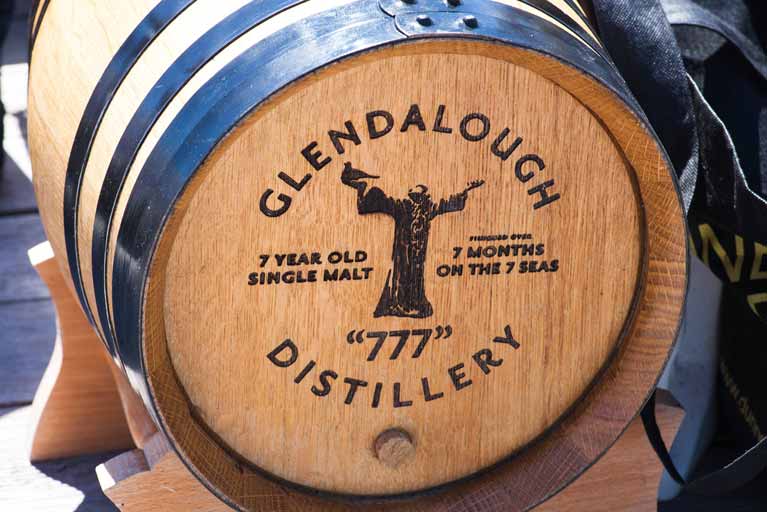 The special barrel of Glendalough 7-year-old single malt whiskey still onboard Gregor McGuckin's dismasted Biscay 36 yacht Hanley Energy Endurance left abandoned some 2.000 miles west of Fremantle, Western Australia after Irish skipper Gregor McGuckin was rescued on 23rd September. By Dec 19, the yacht had drifted to within 1,200 miles of Fremantle. The whiskey is proving an attraction to potential salvors
The special barrel of Glendalough 7-year-old single malt whiskey still onboard Gregor McGuckin's dismasted Biscay 36 yacht Hanley Energy Endurance left abandoned some 2.000 miles west of Fremantle, Western Australia after Irish skipper Gregor McGuckin was rescued on 23rd September. By Dec 19, the yacht had drifted to within 1,200 miles of Fremantle. The whiskey is proving an attraction to potential salvors
At 08:00 UTC Friday, (18:00 local time) French Golden Globe Race leader Jean-Luc Van Den Heede was 40 miles from the film gate at Hobart, Tasmania, his Rustler 36 Matmut making 3.7knots. the 73-year old skipper is expected to sail in to Storm Bay and cross the line shortly after Dawn at 06:00 local time Saturday (20:00 UTC Friday)
All skippers are compelled to pick up a buoy and stop in Storm Bay for a minimum of 90 minutes to hand across film and letters, be interviewed by the media and meet family and team members. No one can board the yachts or provide any assistance and the skipper cannot disembark.
Each skipper will be interviewed live by Race Chairman Don McIntyre and answer questions from media gathered at GGR Race HQ in Les Sables d'Olonne. These interviews will be broadcast live on Facebook www.facebook.com/goldengloberace and coverage of Jean-Luc's arrival is planned to start 30 minutes before as he sails or motors into Storm Bay.
In Ireland throughout July, interest in sailing has been almost completely absorbed by a multiplicity of events in which major happenings such as the Volvo Round Ireland race, Cork Week and the Beaufort Cup have been only the peaks of a continuous tapestry of fascinating sport writes W M Nixon.
Yet during all this time, the competitors in the Golden Globe race have been doggedly making their way southwards – sometimes very slowly as they negotiate the Doldrums and other calm areas - towards their eventual appointment with destiny in the Southern Ocean, and ultimately with Cape Horn.
It’s a measure of the scale of what they’ve undertaken that, after a month, some of the competitors have yet to sail just 10% of the course. But others have been going at it in a much more purposeful way, and as anticipated before the start, the vintage British-built Holman & Pye-designed boats of the Rustler 36 sloop type have proven fastest, holding the five top place with Philip Peche (France) shown as leading with “only” 21,680 miles to sail back to Les Sables d’Olonne, while senior skipper Jean luc van den Heede, also France, is second and The Netherland’s Mark Slats is third.
However, this is with the fleet well spread across the Equatorial Atlantic between Africa and South America, and Ireland’s Conor McGuckian in his Biscay 36 ketch-rigged Hanley Energy Endurance on the western side of the fleet has been having his moments.
He leads all the ketches, he has been up to sixth place on the water when the going was good, and back off Portugal he recorded one of the best day’s runs of the entire fleet. At the moment he’s logging 6.9 knots and due to cross the Equator today (Monday), but with 22,064 miles still to sail.
Race tracker here
Falmouth Celebrates 50th anniversary of Sir Robin Knox-Johnston’s Departure in 1968 Golden Globe Race
Fifty years to the day after Sir Robin Knox-Johnston set out from Falmouth UK in his rugged 32ft yacht Suhaili to become the first man to sail solo non-stop around the Globe, the British master mariner returned yesterday to lead a celebratory parade of sail around the harbour. Watched by visitors on every headland, the 200-strong armada of sail crisscrossed between Falmouth and St Mawes before Sir Robin set up a start line between Suhaili and Sir Francis Chichester’s equally famous yacht Gipsy Moth IV and fired the canon to set the 17-strong fleet of 2018 Golden Globe Race yachts (including Ireland’s Gregor McGuckin in his Biscay 36 Hanley Energy Endurance) on their way to Les Sables d’Olonne for the start of this 50th anniversary solo circumnavigation on Sunday July 1st.
The Suhaili Parade of Sail was the culmination of a 3-day festival involving Suhaili, Gipsy Moth IV, the replica fleet of Golden Globe Race yachts and vessels from around the UK and Europe which had gathered in Falmouth to honour Sir Robin Knox-Johnston’s achievement in the original Sunday Times Golden Globe Race back in 1968/69.
 Start of Falmouth to Les Sables-d’Olonne race – Gregor McGuckin’s Biscay 36 Hanley Energy Endurance on the right
Start of Falmouth to Les Sables-d’Olonne race – Gregor McGuckin’s Biscay 36 Hanley Energy Endurance on the right
The Mayor of Falmouth, Cllr Grenville Chappell said: “It’s amazing to think it was 50 years ago - it seems only yesterday - that Falmouth welcomed Sir Robin Knox-Johnston back into port after his incredible and historic sailing achievement, one that captured the hearts and minds of millions of people around the world. His exploits then and subsequent, have inspired many across the UK and beyond to get out on the water, take up sailing or indeed undertake their own adventures. It certainly made an indelible mark on Falmouth’s community and we are thrilled to see Sir Robin and his legendary yacht Suhaili back in town. We’re delighted to be the host port for the Suhaili 50 Falmouth Parade of Sail jamboree. Our community has come together so well to assist, so a particular thank you to Falmouth Town Council, Falmouth BID, Falmouth Harbour Commissioners, Royal Cornwall Yacht Club, St Mawes Sailing Club and St Austell Brewery for their support.”
"The Suhaili Parade of Sail was the culmination of a 3-day festival involving Suhaili, Gipsy Moth IV & the replica fleet of Golden Globe Race yachts"
Sir Robin Knox-Johnston said: “It is wonderful to be back in Falmouth and to receive such a warm welcome. Everyone has been very kind. This week’s celebrations have brought back so many memories.”
One of those memories is of a barometer, ‘borrowed’ off a pub wall before Sir Robin set out on his solo first which he used to monitor the changing weather conditions during his 312 day voyage. The original was later stolen from his yacht but Sir Robin returned with a replica of that faithful 'A Lovely day for a Guinness' branded barometer to present to the Chain Locker Pub where he stayed 50 years ago before his departure and on his return.
And to mark his return to this famous harbour-side hostelry, staff served Sir Robin with the same meal of steak and chips followed by lemon meringue pie he had ordered when he first returned to Falmouth on 22nd April 1969.
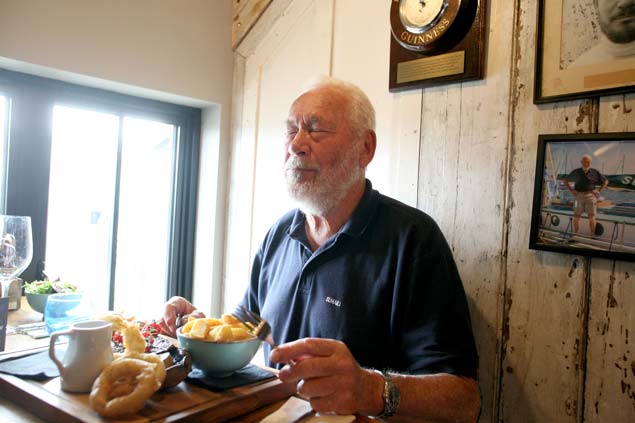 Robin Knox-Johnston savours the moment with a re-creation of the meal he had in The Chain Locker pub on Falmouth town waterfront when he returned from his great voyage 50 years ago.
Robin Knox-Johnston savours the moment with a re-creation of the meal he had in The Chain Locker pub on Falmouth town waterfront when he returned from his great voyage 50 years ago.
First of the 2018 Golden Globe Race yachts to cross the line at the start of the SITRaN Challenge race to Les Sables d’Olonne was Tapio Lehtinen’s Finnish yacht Asterisk closely followed by 72-year old Jean-Luc Van Den Heede’s French entry Matmut and the two bright orange painted entrants Mark Sinclair’s Australian yacht Coconut and Istvan Koper’s USA/Hungarian entry Puffin, with Gregor McGuckin’s Hanley Energy Endurance settling into fifth place as the fleet reached open water.
Palestinian skipper Nabil Amra, who has still to complete his 1,000 mile solo proving trial, set out later in the day and must sail a further 300 solo distance once he arrives at the French port in order to qualify for the Race.
Sunday 22 April marks 49 years since Sir Robin Knox-Johnston returned to Falmouth after spending 10-and-a-half months racing solo, non-stop around the world on is yacht Suhaili to win the Sunday Times Golden Globe Race.
Sir Robin, who went on to establish the Clipper Race to enable everyday adventurers to experience the thrill of ocean racing for themselves, reflects on that historic day in 1969.
“The night of the 21 April 1969 was not a restful one for me. I was heading in towards the Lizard, aiming to round it at daybreak on the 22 April, but my route was seriously busy with a couple of hundred French fishing boats square dancing across my path. Half of Brittany seemed to be at sea off the Cornish coast.
“The last couple of days had been busy with boats full of journalists appearing from all directions and demanding comments, a huge contrast to the solitude of the previous 310 days. At times I began to wonder whether I should not turn round and slip away and carry on being what I had become after ten and a half months alone: a creature of the sea with no need for other human company.
“The night was a long one. I did not dare sleep in case a fishing boat misread my paraffin pressure lamp, which was the only navigation light I had left working. Fortunately I had two faithful escorts: Fathomer with my friends aboard, and Queen of the Isles, the Scilly ferry charted by a newspaper. Both kept close to discourage the fishing fleet.
“At daybreak I was off the Lizard and was asked when I thought I would cross the finish line off Black Rock Beacon in Falmouth. The wind was fair and 0900 seemed a sensible ETA. But this created a problem I could not have imagined. A boat closed in and yelled would I slow up please as the Mayor and Mayoress were going to meet me and the Mayoress had a hairdressers’ appointment for 0900.
“I remonstrated. All I wanted was a cigarette (I had run out 40 days before – its will power really!) a pint of bitter, a steak, (I had lived off tinned food for the whole voyage and wanted something I could chew) and a bath, in that order.
“But after all this time away from fellow humans, and as I approached the end, I was losing my usual aggressive response to any threat and I slowed down.
“It was a disastrous mistake. At 0730 a front came through, no forecasts in those days, all I had was a barometer I had stolen from a pub.
“Suhaili does not beat to windward well (neither does her owner!) and the wind was now blowing directly from Falmouth Harbour. The Mayoress had all the time she wanted for her hair appointment, in fact too much, as I did not cross the finish line until 1525 in the afternoon of 22 April, by which time her hair do had been blown away.
“I was tired after two days without sleep but now exhilarated at the thought of getting home. I managed to avoid contact (except with the BBC launch) with the fleet of boats that had come out to escort me in and headed for the finish.
“But as I crossed the finish line at the entrance to Falmouth Harbour, which I had last passed on the 14 June 1968, a large customs launch came alongside and two immaculate customs officers jumped aboard my poor battered little boat and gave the usual greeting. ‘Good afternoon, captain,’ they said, ‘where from?’
“There was only one answer. ‘Falmouth!’ I responded.”
Nine sailors started the Golden Globe race; and amid various retirements and boat breakages plus the well-documented loss at sea of Donald Crowhurst (Robin ended up donating his £5,000 prize money to a fund supporting Crowhurst’s family), Sir Robin Knox was the only entrant to complete it.
The 30,000-mile voyage in his sturdy 32ft yacht Suhaili took 312 days, and Sir Robin returned to Falmouth on April 22 1969 as a modern hero, with his achievement remaining one of the most significant small boat sailing achievements in history.
Thursday 14 June marks the 50th anniversary of the day Sir Robin departed from Falmouth on his now historic voyage. To celebrate this achievement. a special Suhaili Falmouth 50 Parade of Sail is set to take place.
The three-day commemorative event, organised by the Falmouth Town Team and the Royal Cornwall Yacht Club, promises to be quite a spectacle.
Sir Robin will sail in to Falmouth aboard Suhaili on Monday 11 June, joined by two other historic solo circumnavigators — Sir Francis Chichester’s Gipsy Moth IV, and Sir Alec Rose’s Lively Lady — together with the entire fleet of yachts and skippers who are preparing to take part in a 50th anniversary race, established in tribute to Sir Robin’s historic voyage.
The 2018 Golden Globe Race will start on Sunday 1 July from Les Sables-d’Olonne in France. In contrast to the current professional world of elite ocean racing, and even the corinthian spirit of the current Clipper Race, this tribute race is designed to celebrate the ‘Golden Age’ of solo sailing.
In a solo, non-stop around the world race, via the five Great Capes, returning to Les Sables-d’Olonne, entrants will be limited to sailing similar yachts and equipment to what was available to Sir Robin.
The challenge is pure and very raw. Competitors will be navigating with sextant on paper charts, without electronic instruments or autopilots. They will hand-write their logs and determine the weather for themselves. Only occasionally will they talk to loved ones and the outside world when long-range high frequency and ham radios allow.
It is now possible to race a monohull solo around the world in under 80 days, but sailors entered in this race will spend around 300 days at sea in little boats, challenging themselves and each other.
'The Mercy' Sailing Film Trailer Starring Colin Firth is Released
The trailer for the much awaited film, The Mercy, which stars Colin Firth and Rachel Weisz as Donald and Clare Crowhurst, have been unveiled. The movie opens nationwide on 9 February. The film recounts the story of Crowhurst disastrous attempt to win the 1968-69 Golden Globe Race.
The Mercy is due to be released in the UK on 9 February 2018, ahead of the 50th anniversary Golden Globe Race, which starts on 30 June 2018 from Plymouth and will have an Irish entry.































